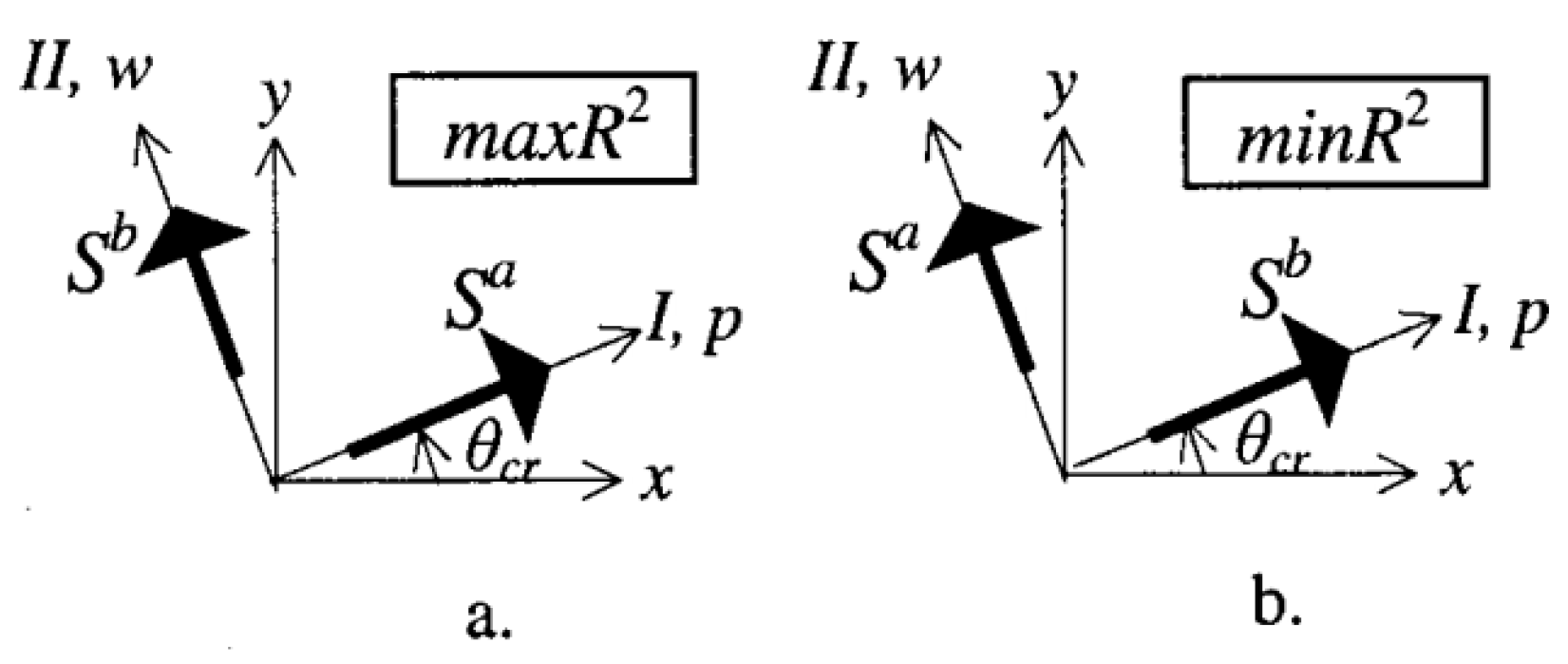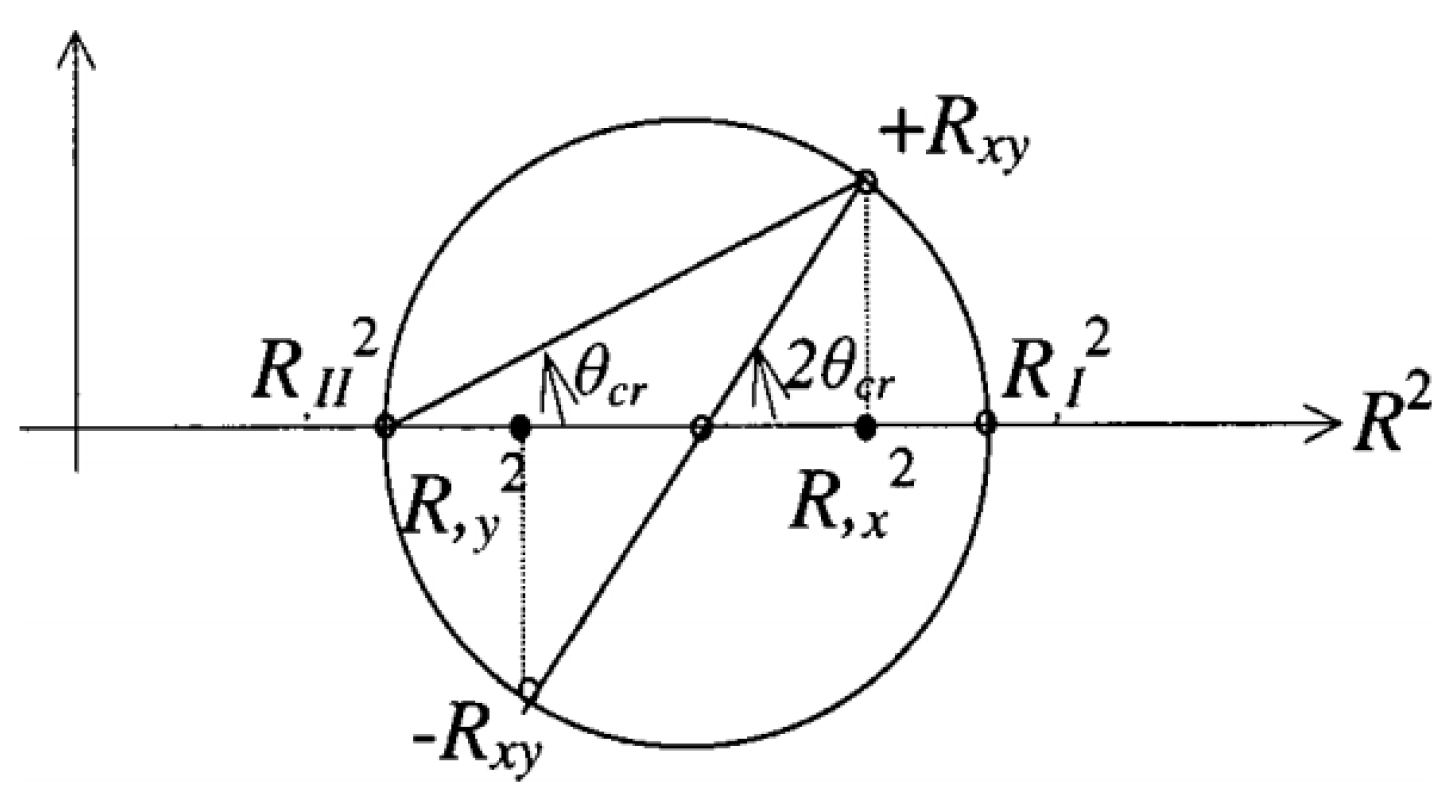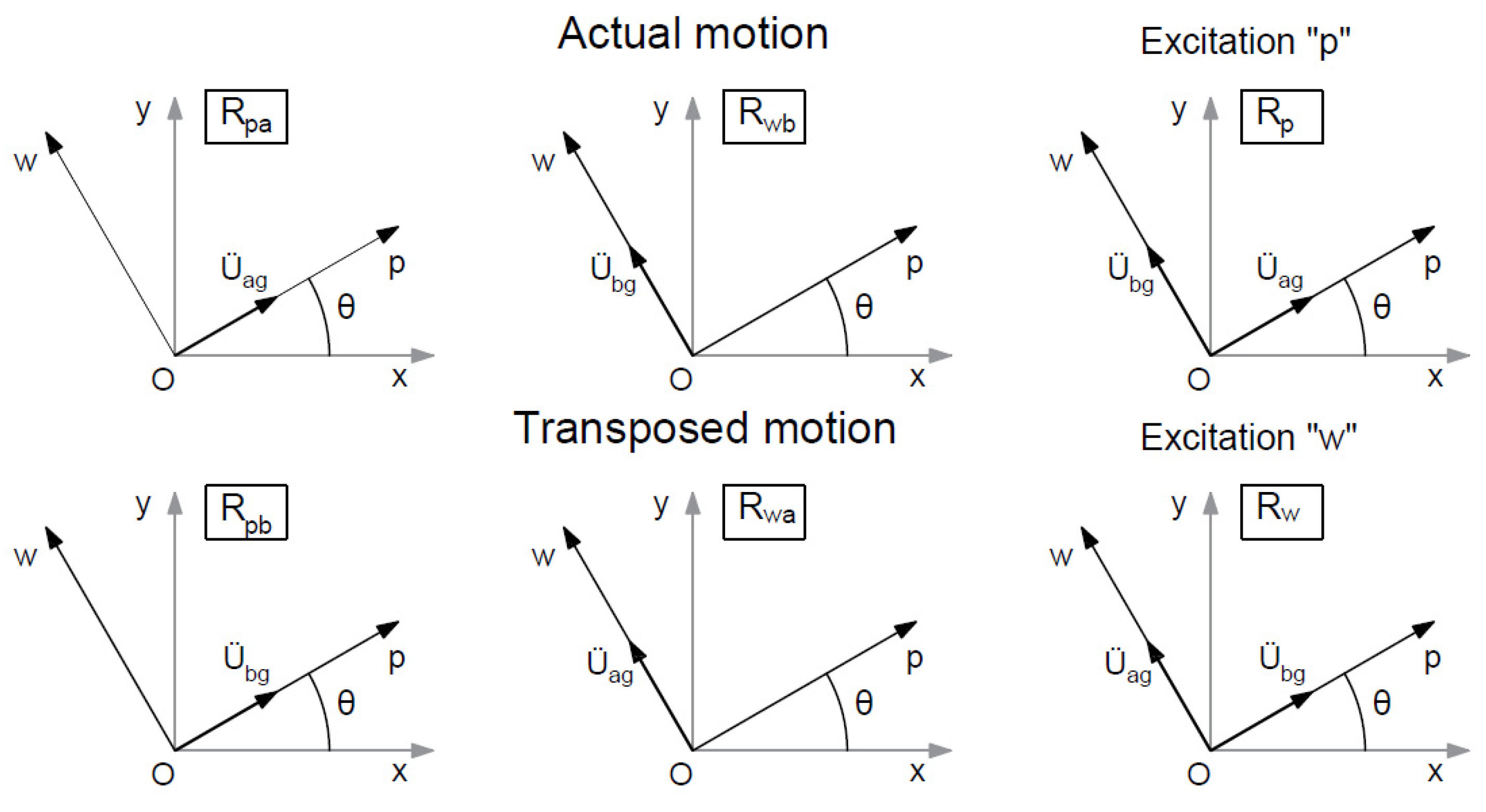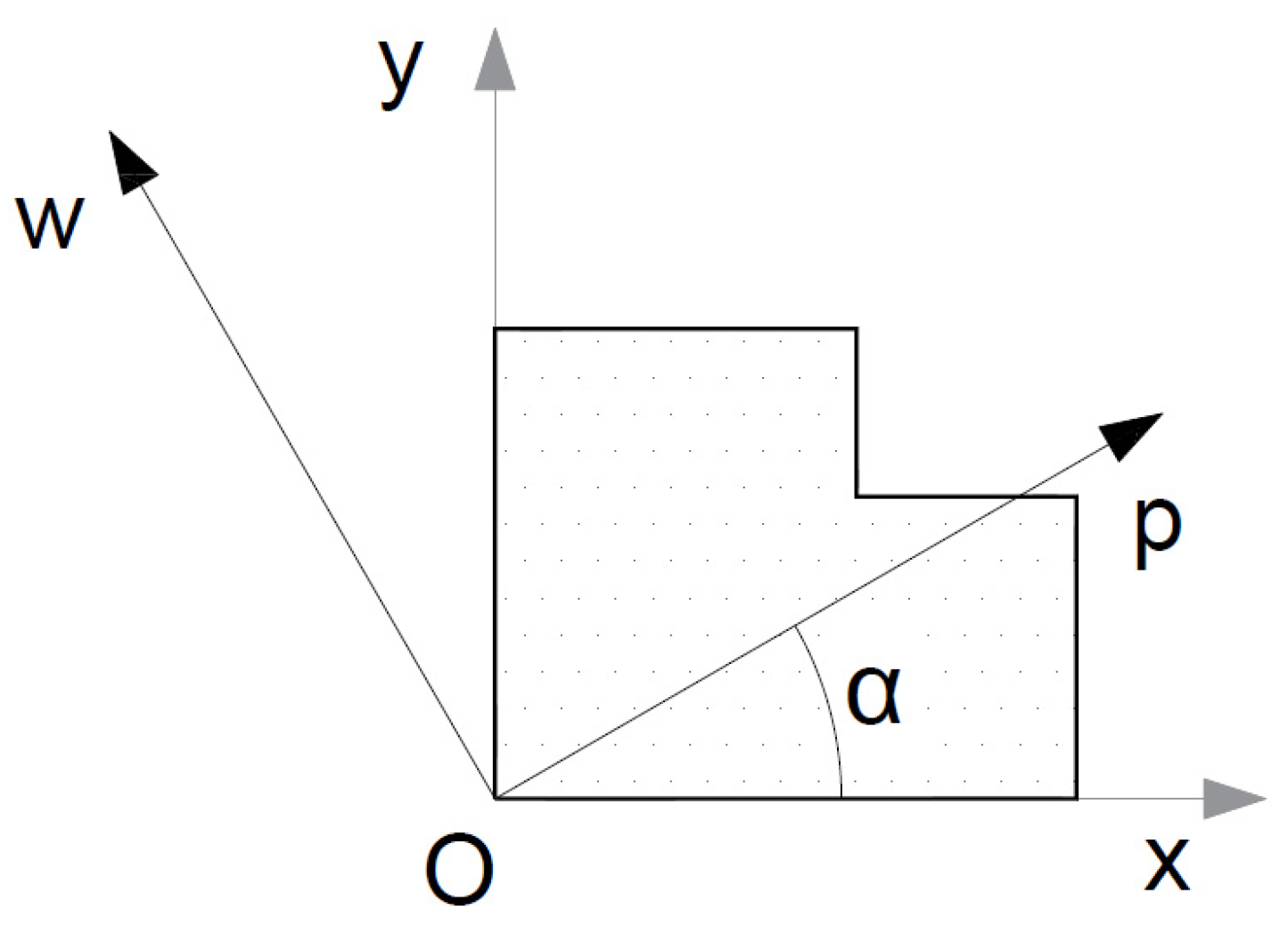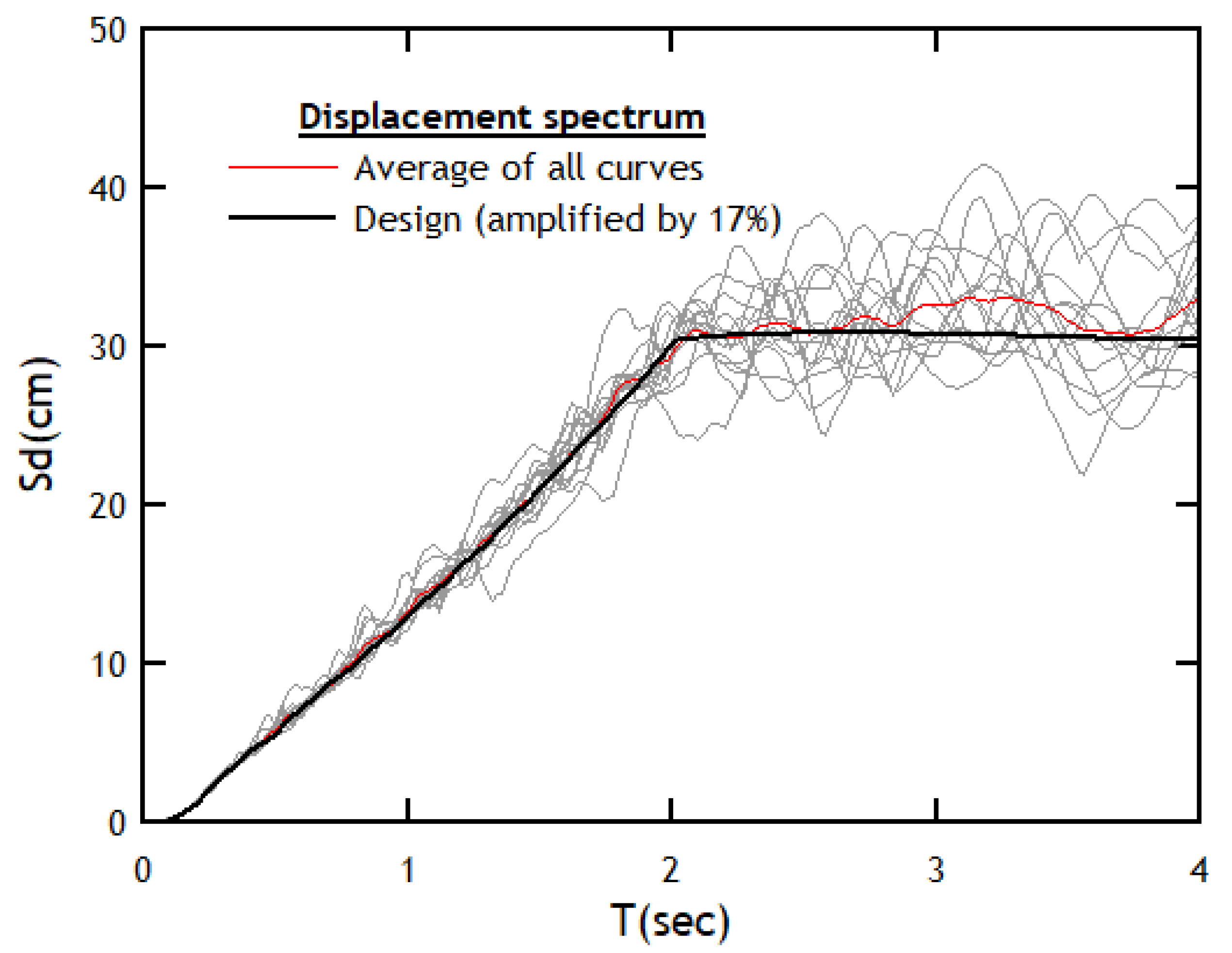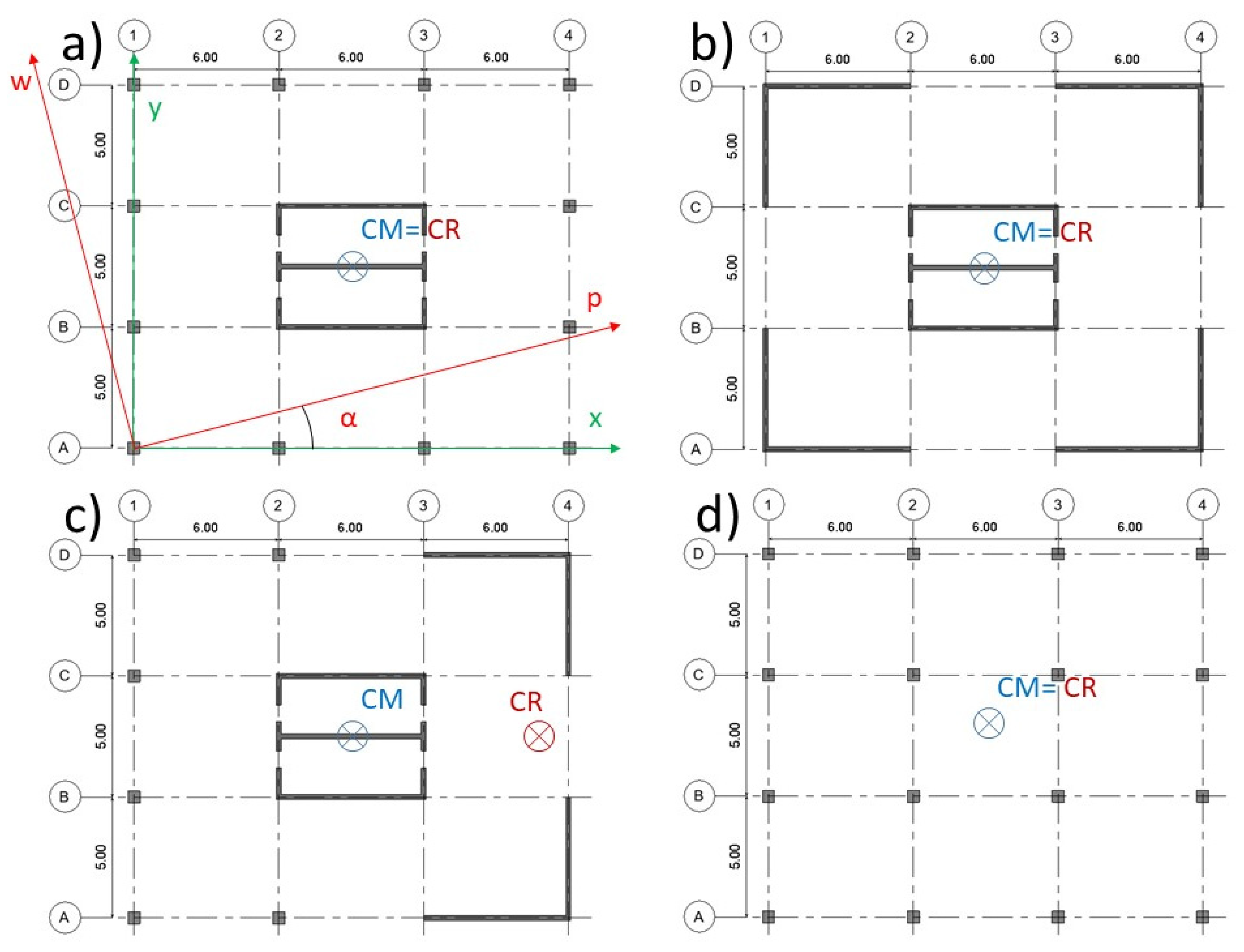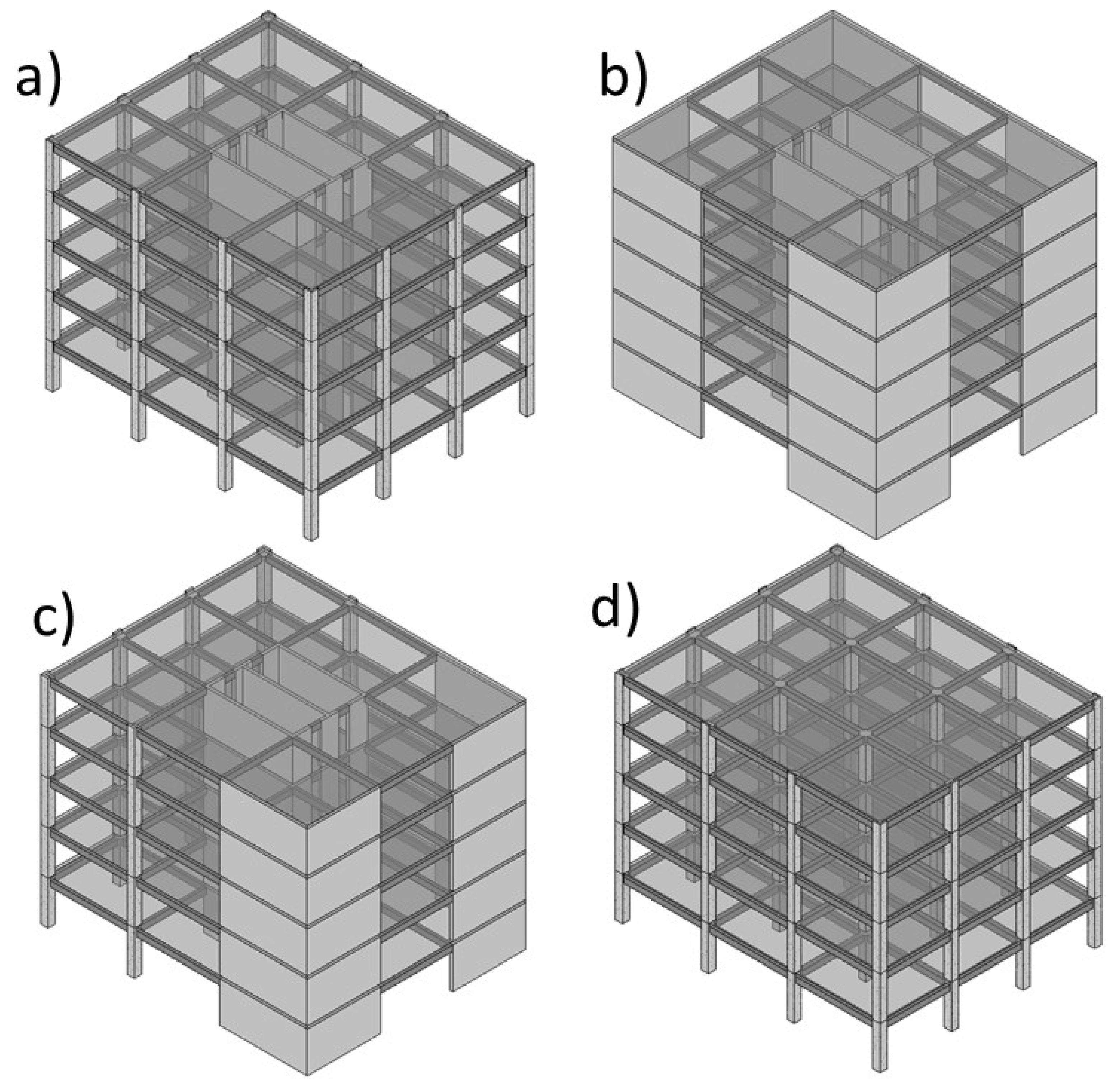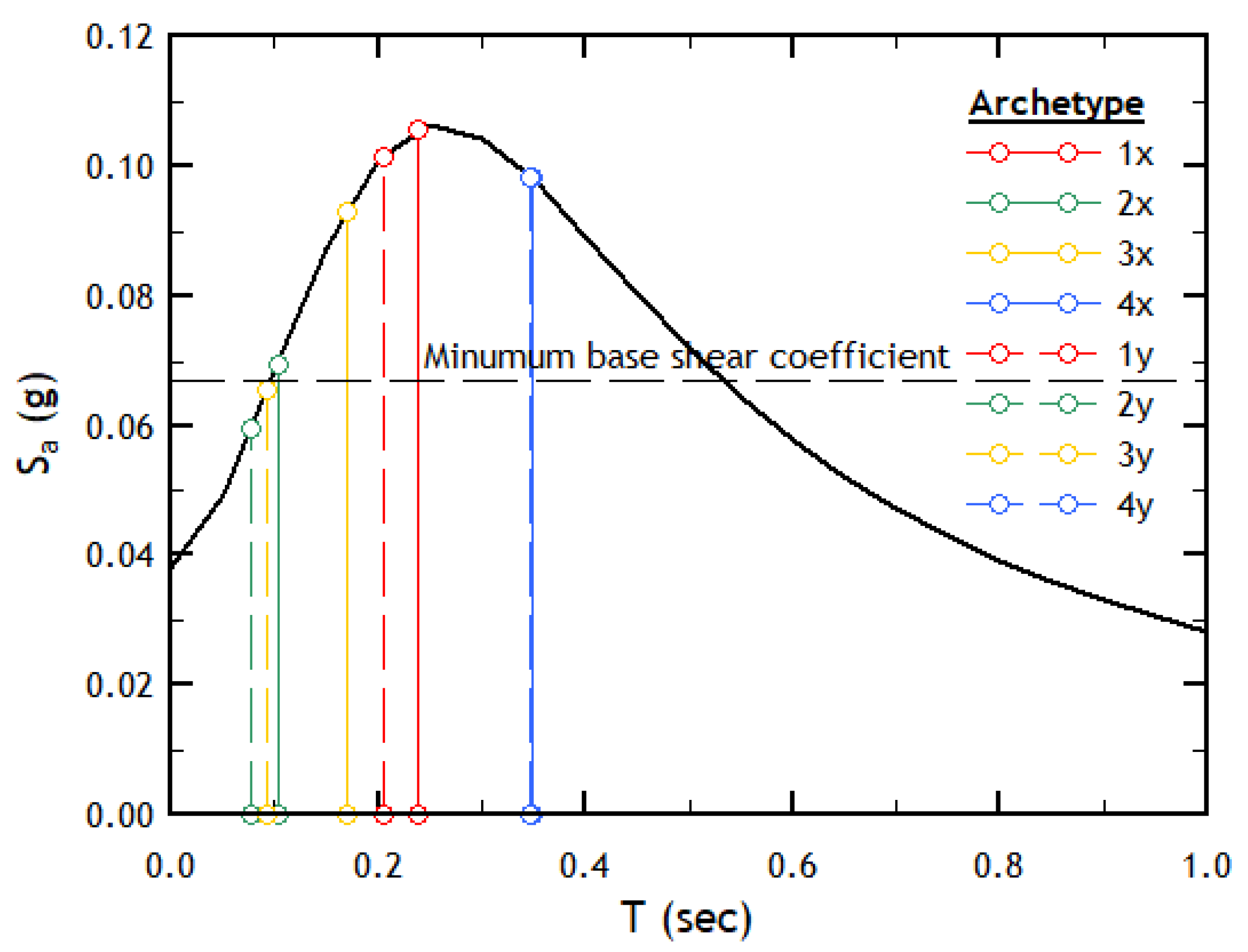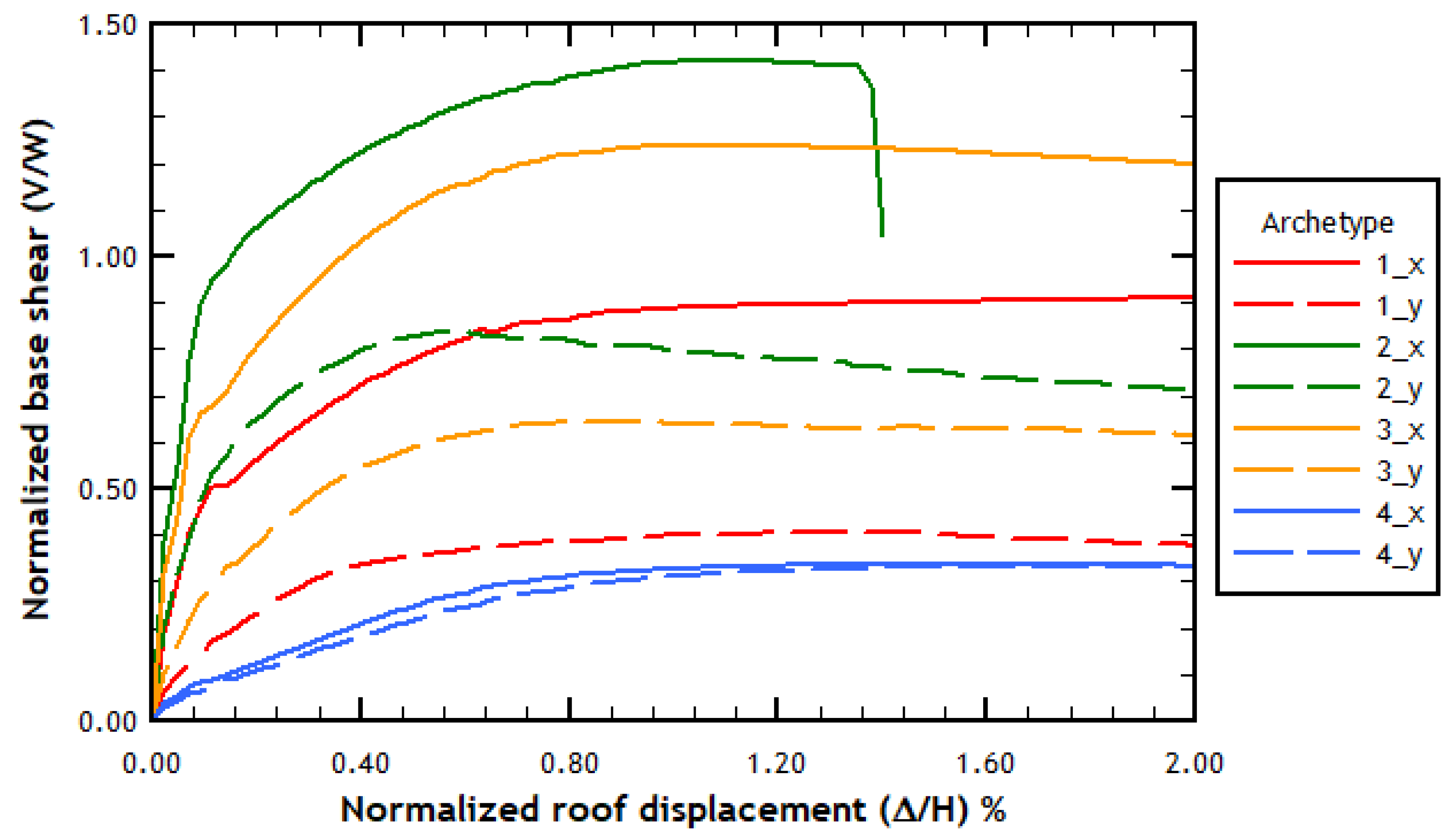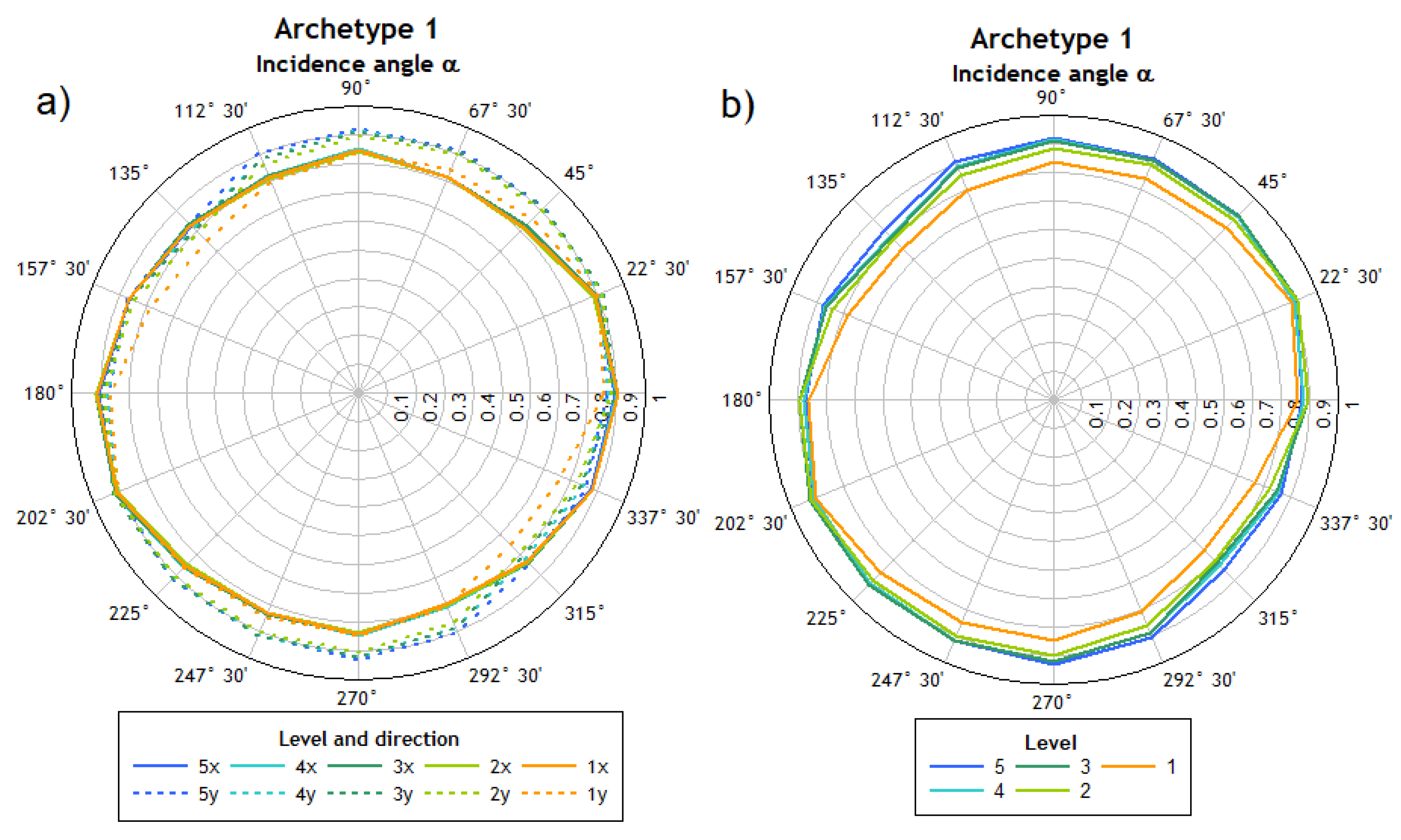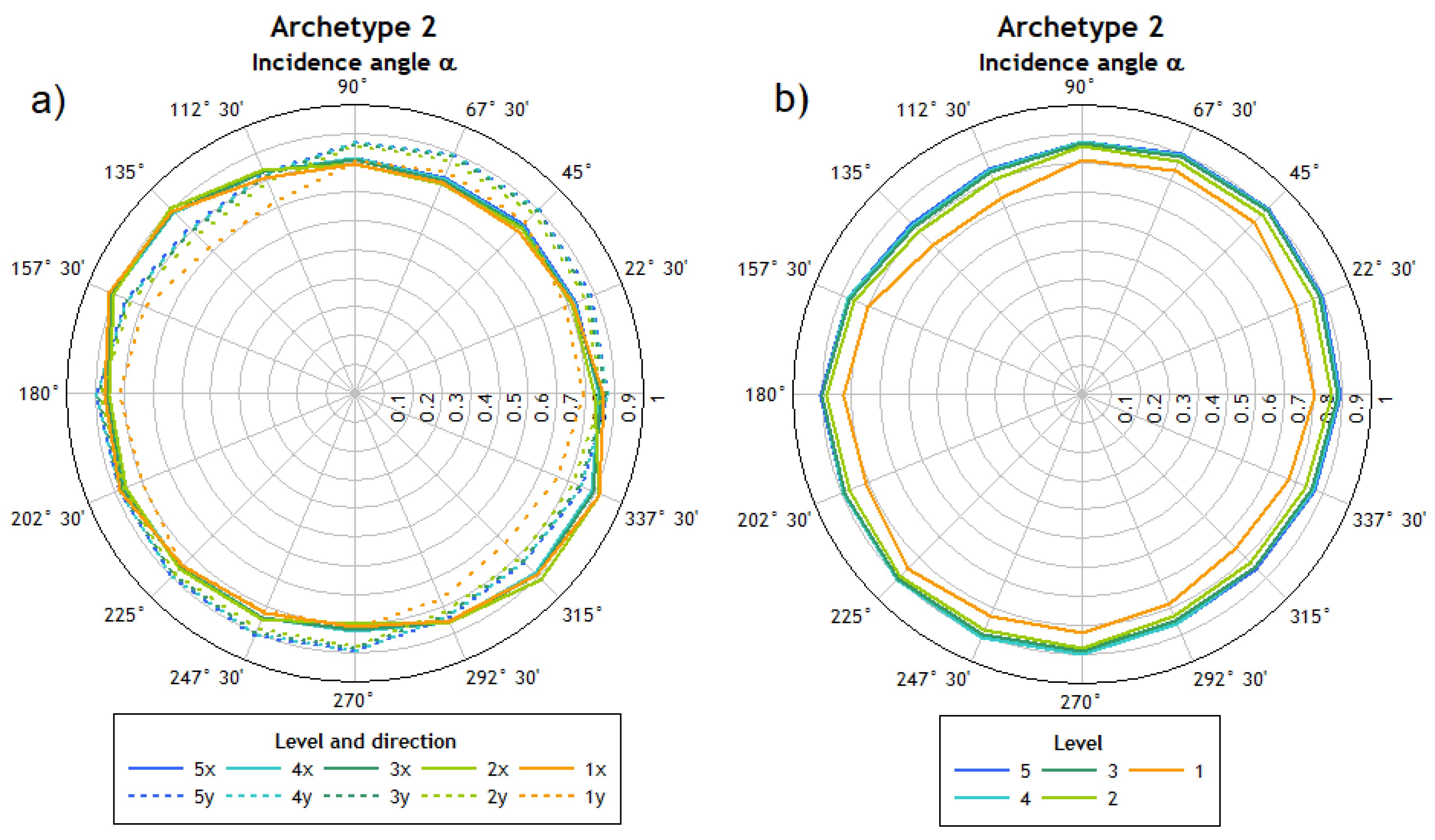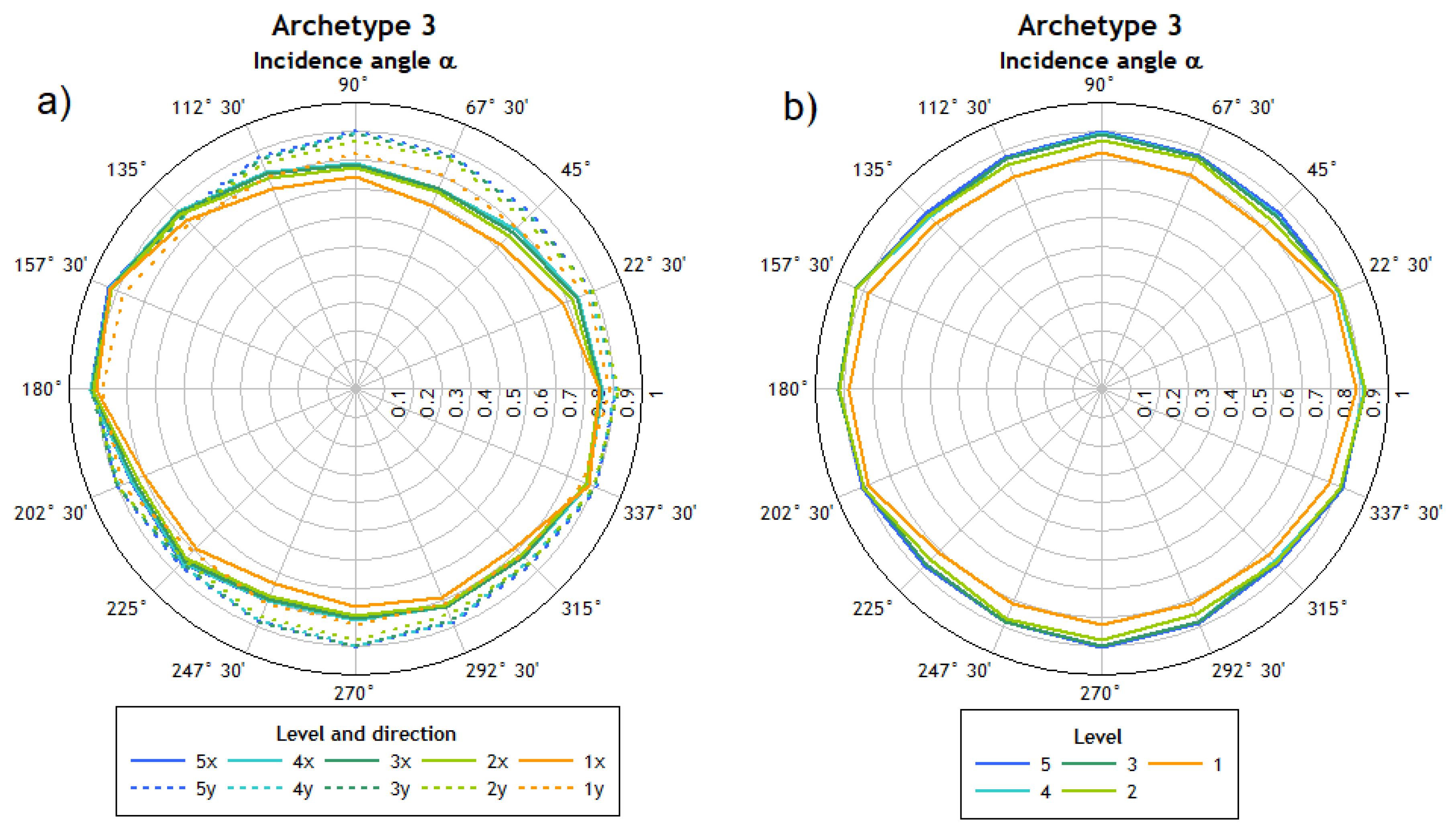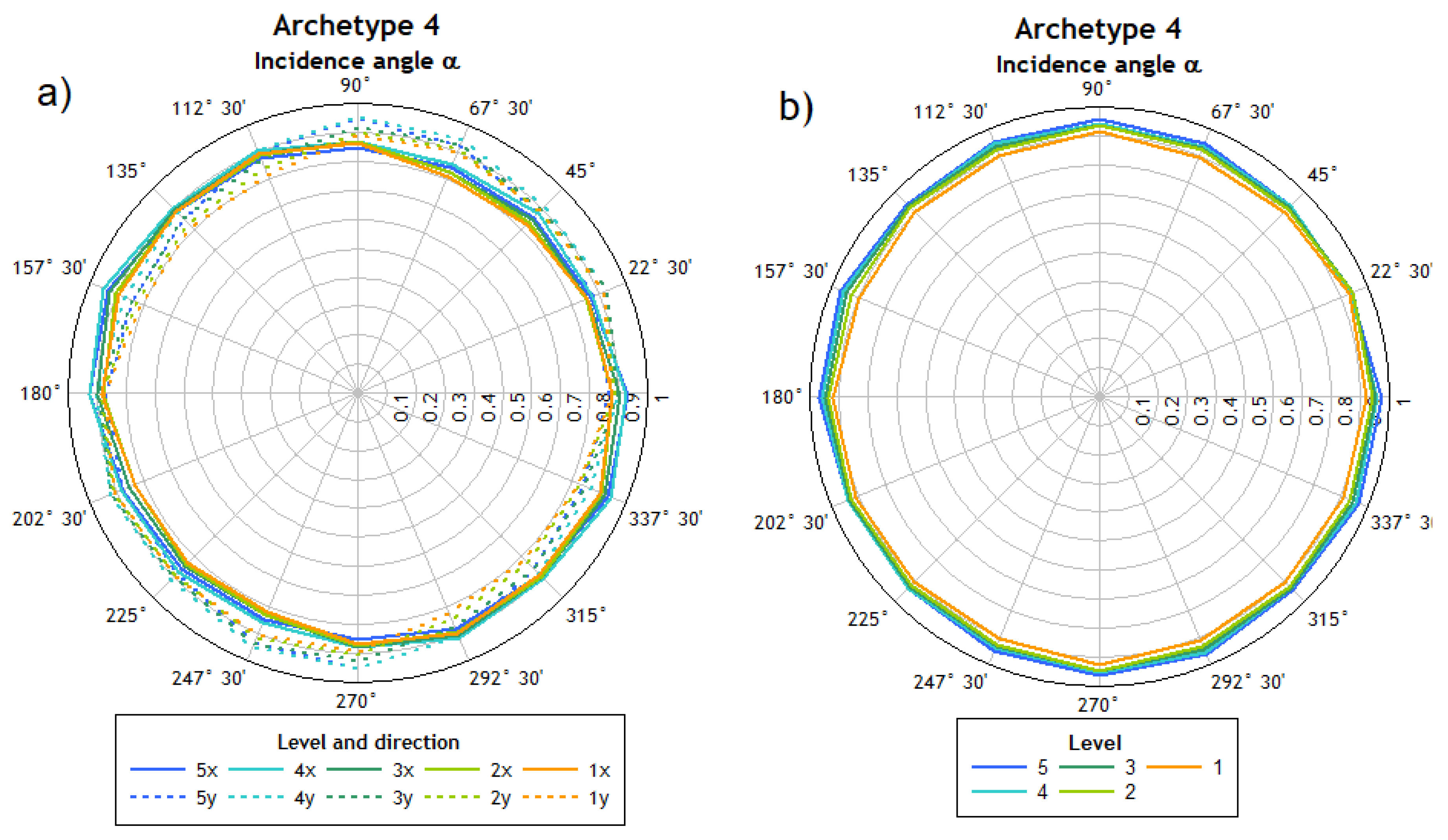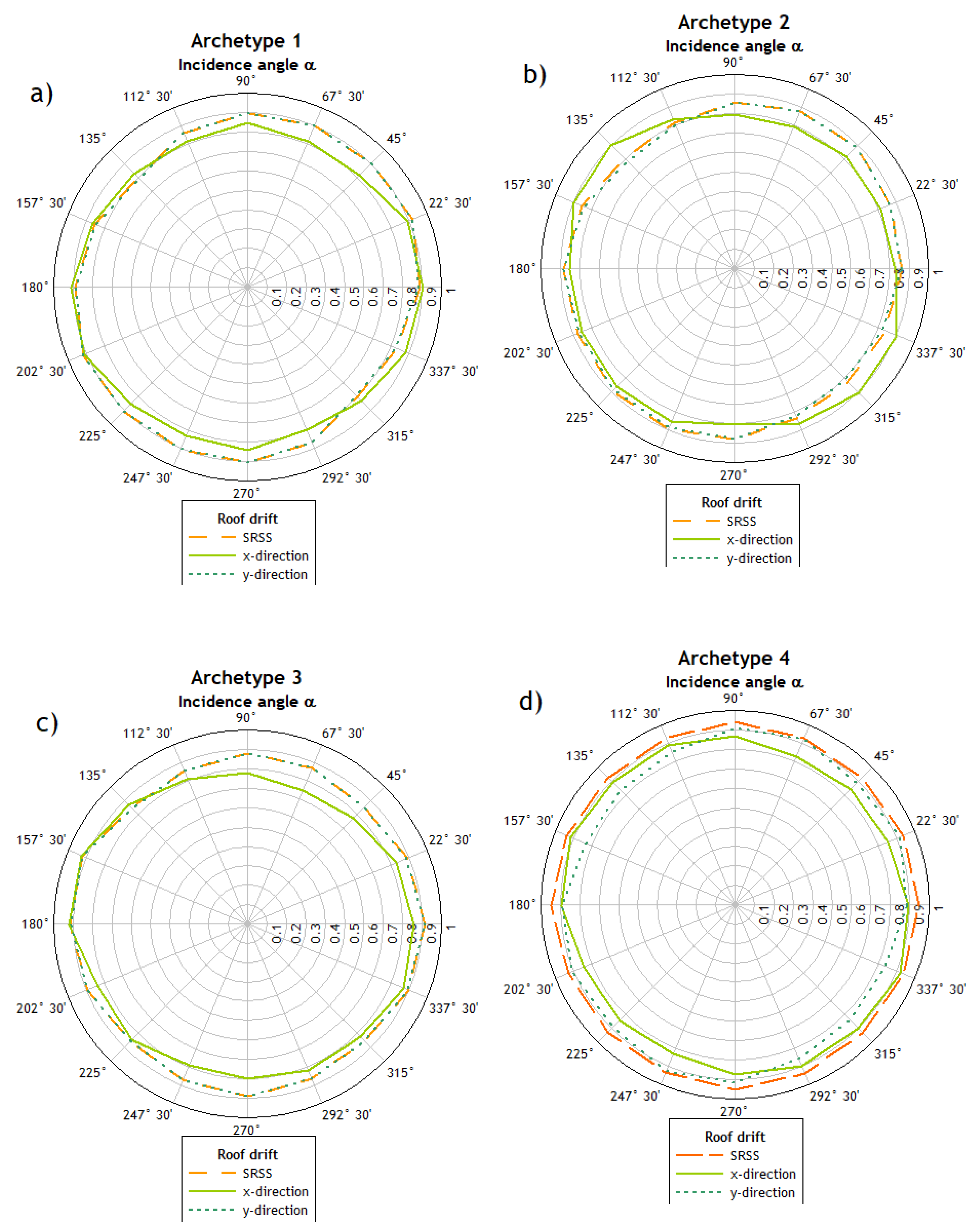1. Introduction
At present, the seismic-resistant design of structures is based on the results of the seismic analysis carried out considering two components of ground acceleration, which are transformed into seismic forces that act in two directions. The problem lies in determining the proportions in which the application of the accelerations, and thus the design of seismic forces, must be carried out, as the combination of the proportions can lead to results that are either on the conservative side or on the low side. In particular, the angle of incidence considered when performing the seismic analysis becomes important when determining the demands to which the structure will be subjected (MacRae and Mattheis [
1]). For example, Athanatopoulou et al. [
2] concluded that the estimation of interstory drift due to bi-directional earthquakes is dependent on the chosen reference axes, which is especially important in irregular structures. On the other hand, Rigato and Medina [
3] obtained variations of up to 80% between the maximum inelastic deformations calculated with angles of incidence different from the usual ones (0° and 90°). On the other hand, underestimation in engineering demand parameters (interstory drifts and displacements) can be reduced by up to 20% by performing nonlinear time-history analysis with a large number of records in normal directions and parallel to the fault (Reyes and Kalkan [
4]). However, these types of solutions may not be practical in Chilean territory given the extension of the active seismic zone. Regarding the errors observed, according to Kashkooli and Banan [
5], mean maximum errors have been reported for story displacement and interstory drift of up to 22% and 42%, respectively, or errors of up to 37% in roof displacements and rotations in plastic hinges (Magliulo et al. [
6]). Finally, Prajwal et al. [
7] reported variations in displacement demands of up to 90%.
The direction in which the earthquake interacts with the structure is arbitrary, so the structural axes do not necessarily correspond to the main axes of movement, which would present the most unfavorable situation. To study this characteristic, Rigato and Medina [
3] obtained the response of asymmetric and symmetric structures by varying the degrees of inelasticity, vibration periods, and incidence angles used, observing that the response varies depending on the fundamental period, structuring, and degree of inelasticity. In the analyses, two archetypes were used, varying the angle of incidence in increments of 5° from 0° to 180°. According to the authors, the ratio between the maximum inelastic deformation for a given angle and the maximum obtained for an angle of 0° and 90° tends to increase along with the fundamental period, averaging between 1.1 and 1.6 for torsionally balanced and unbalanced models. It was concluded that the structural axes are not necessarily the most unfavorable and that the critical incidence angle varies depending on the intensity of the record. On the other hand, Lagaros [
8] studied two different structures, using three records and incidence angles in increments of 5° varying from 0° to 360°. These records were used as a basis to scale an acceleration spectrum considering the first period of the structures, damping of 5%, and three levels of intensity. The response of the structures varied according to the records, intensity level, and incidence angle.
In order to study the effect of the directionality of earthquakes on structures, nonlinear response analysis has frequently been used. Cantagallo et al. [
9], studied the influence of directionality on seismic response variation, including in the study the variation of the angle of incidence between 0° and 180° in increments of 22.5°, reaching the conclusion that, for the analyzed structures, the main axes underestimated the demand, especially in plan irregular structures, while in structures with double symmetry, no considerable variations were obtained. Additionally, it was observed that the effects of directionality are lower in scaled seismic records. It should be noted that only four structures were considered in this study, so these results are limited.
Fontara et al. [
10] studied the influence of the orientation of the seismic action and its intensity on single-story asymmetric reinforced concrete structures. The sensitivity of the structure to the angle of incidence varied depending on the degree of incursion in a nonlinear range; as the level of damage increases, the variability in the results as a function of the angle of incidence increases as well. The results indicated that the most unfavorable case was not obtained in the structural axes; that scaling the records using the same scale factor allows for similar levels of damage regardless of whether they are recorded, correlated, or not correlated; and that, if different scale factors are used, different levels of damage are obtained at the critical angle.
The influence of the angle of incidence of an earthquake has mainly been determined using three-dimensional nonlinear time-history analysis on reinforced concrete frame structures of between one and four stories, not necessarily applying both records simultaneously. This is found in several works [
3,
8,
10,
11,
12], among others, with increments of incidence angles ranging from 1° to 22.5°. The highest structure analyzed in order to study the angle of incidence had nine stories (Kalkan and Reyes [
12]). With this, it was determined that, when performing a nonlinear time-history analysis, the records should be applied in the maximum direction, this being the direction in which there is the greatest linear response of a mass with degrees of freedom in both horizontal directions: the normal direction and that which is parallel to the fault, at sites less than 15 km away from the fault. The recommendation given is based on the low attenuation observed in propagating waves within this range. Although the previous recommendations would not represent the worst case, they would deliver higher demand parameters than usual. Recently, dynamic incremental analysis has gained special importance in evaluating the response of various structural types [
13,
14,
15] or even in determining their seismic design factors [
16], but this type of analysis is usually computationally expensive in all its phases.
Many authors have tried to estimate, generally, the least favorable angle of incidence or the response given by it, and to express this through formulas. An example of this has been the procedure applied to reinforced concrete structures (Wilson and Button [
17]). Although this procedure is practical in design, as it is based on modal response spectrum analysis, it does not take into account the components of the earthquake when they act on the main structural axis. Meanwhile, Smerby and Der Kiureghian [
18] have indicated that the previous method had certain limitations. The problem has continued to be studied by González [
19], even applying linear analysis, obtaining relative errors of up to 30%. A formula for determining the critical incidence angle has been proposed by Wilson et al. [
20] based on linear response spectrum analysis or modal response spectrum analysis to determine the critical angle, using five load cases and three response spectra (López and Torres [
21]).
Response spectra are commonly used in the definition of seismic action, so it is advisable to study their application by explicitly using the definition of directionality (Anastassiadis and Panetsos [
22]). Regarding the results, the different types of analysis used tend to significantly affect their deviation from those obtained through conventional analysis. For example, a bridge with curvature in plan studied by Gao et al. [
23] using nonlinear time-history analysis, combined with seismic records with incidence angles varying between 0° and 180° in 6° increments, presented variations in force and moments of up to 45% with respect to the conventional analysis. Similar studies [
24,
25,
26] that have addressed the use of different types of analysis present different results regarding the influence of the angle of incidence on the maximum responses of the structures.
Next, some of the cited works are presented in greater detail, which will allow a better understanding of the different approaches that have been applied to the problem.
1.1. Wilson and Button
They consider two response spectra applied at angles of 0° and 90°, evaluate the forces obtained using the CQC combination [
17], and subsequently determine the critical angle of incidence by means of the following equation:
where
is the factor that multiplies the response spectrum and
and
are the responses obtained for an angle of incidence of 0° and 90°, respectively.
1.2. González
In this work, three structures were analyzed with the proposed methodology that consists of calculating the maximum response in each vibration mode using the angle of incidence of the earthquake as a parameter and subsequently combining the results with any modal combination criterion [
19]. The displacement and stress results were compared using nonlinear time-history analysis and modal response spectrum analysis as a basis. It was concluded that the SRSS combination presented the best results in conjunction with the proposed method.
1.3. López and Torres
The authors propose addressing the problem of directionality through modal response spectrum analysis, solving five load cases [
21].
The proposed method consists of the following:
Solving the five spectral modal load cases to obtain the response parameters.
Using Equation (3) to obtain the critical angle of incidence.
Using Equation (2) to obtain the maximum responses for each critical angle of incidence.
It should be noted that each parameter can have a different critical angle, where
is the peak response of the chosen parameter,
is the participation coefficient, and
is the critical incidence angle, calculated using the following equations:
In Equations (2) and (3), and are the peak modal responses obtained along the structural reference axes x and y, respectively. Finally, is the peak modal response in the vertical axis z.
1.4. Menun and Der Kiureghian
The authors propose the use of the CQC3 combination as an alternative to the multicomponent combination (instead of the use of SRSS, CQC, and rules of 30% or 40%) [
27]. Additionally, a formula is proposed for the calculation of the critical angle, where
and
represent the axes and the seismic components considered,
is the coefficient of participation related between the modes and the indicated direction,
corresponds to the correlation coefficient between modes, and
is the ratio between the design spectra used. Finally,
correspond to the kth principal axis of the ground motion. The equations are presented below:
1.5. Anastassiadis and Panetsos
This method is based on previously published considerations presented by Penzien and Watanabe [
24], which are used by means of the response spectra when considering the existence of a major axis in the direction of the epicenter, intermediate transversal, and minor vertical, this being valid only when the effects of proximity to the fault are absent. The proposed seismic design is based on determining the critical orientation that provides the greatest response, on calculating maximum and minimum response values and on the application of the extreme stress or extreme force method to determine the most unfavorable combination of the resulting stresses acting on specific structural elements [
22]. To determine the critical direction, the reference systems indicated in
Figure 1 and the following equations should be used:
In Equations (10)–(12),
represents the correlation coefficients between the modes
and
. A graphical representation of the reactions calculated using Mohr’s circle is shown in
Figure 2.
1.6. Dongsheng et al.
This method corresponds to a simplified version of the CQC3 method. The similar method SRSS3 was introduced for the first time by Gao et al. [
23], who postulate that this method presents considerable errors if there is a high correlation between the vibration modes of the structure, otherwise it gives similar results to the CQC3 method. The equations presented below takes into account the proportionality between the design spectra in each direction of analysis [
28].
1.7. Athanapoulou et al.
The authors presented an analytical formula to determine the critical incidence angle for structures subjected to three correlated seismic components. This implies solving three time-history cases (one for each component) without the use of the model of Penzien and Watanabe [
24] and assuming linear behavior, as response spectra cannot be used because correlation of the records is assumed. The object of the study was an irregular structure with five stories [
26].
Figure 3 and
Figure 4 show the reference axes considered and a graphic representation of the reactions indicated.
The equations necessary for the calculation of the critical angle are presented below, where
corresponds to the angle for which the maximum response is obtained and
to the minimum response of the envelope
, both taking into account the signs.
where
and
are the critical times when the maximum positive and minimum negative displacements occur.
1.8. Lagaros
Multidirectional incremental dynamic analysis (MIDA), using pairs of records and incident angles generated by Latin hypercube sampling (LHS), has been proposed to take into account the variability of seismic excitation and the angle of incidence, focused on the implementation of incremental dynamic analysis for performance-based design [
29]. One symmetric and one asymmetric structure (both of three stories) were analyzed, considering fifteen records and an incidence angle between 0° and 180°, uniformly distributed for the generation of the sample using LHS. Subsequently, the MIDA and its respective representative MIDA curve were performed.
To perform the MIDA, intensity measurement must be selected, such as peak ground velocity (PGA), peak ground acceleration (PGV), a spectrum related to the damping and the first period, and so on. Then, the engineering demand parameter must be determined, which was categorized into maximum deformation, cumulative damage, and global parameters [
30]. The interstory drift measurements are based on maximum displacements, and are used in this analysis as there is an established relationship between such measurements and the performance of the structures: immediate occupation, life safety, and collapse prevention (FEMA 273 [
31]).
In summary, the method consists of the following:
Selection of records;
Selection of intensity;
Selection of engineering demand parameter;
Sample generation using LHS;
Carrying out MIDA and its curves.
1.9. Summary of the Studies That Analyze the Influence of the Angle of Incidence
The studies shown so far include relevant procedures that are directly applied to determine the seismic response of structures, either at the regulatory level [
27] or at the level of research carried out on structures whose importance or irregularity requires more refined procedures of analysis [
29]. On the other hand, these procedures serve as a basis for questioning the regulatory application of address combinations [
19,
21,
26], among which is the combination of 100% and 30%, or the way in which the results are combined [
19,
22,
28] to obtain the stresses that will be applied in the structural design. These studies have served as the basis for determining the influence of the seismic action’s incidence angle on different structural types that are presented below. A numerical study will be applied to a set of representative archetypes of various structural typologies, which will make it possible to obtain the maximum demands in displacements (produced by means of a nonlinear time-history analysis combining the two components of strong earthquakes that occurred in Chile), and in which the angle of incidence has been allowed variation in order to determine under which angle the highest demands are reached.
3. Definition of Case Studies
To study the combined effect of the angle of incidence of the seismic action and the symmetry of the structures, a set of archetypes was defined in which different structural typologies were used that gave rise to symmetric and asymmetric configurations. It is important to clarify that the symmetry being studied refers to the orientation plane of the structural axes (
and
), as asymmetry in elevation (with respect to the
axis) is outside the scope of this study. The conventional axes found in the literature (shown in
Figure 5) were used as reference axes, where
and
correspond to the orthogonal axes that define the structure and that are commonly used in its design and analysis. Meanwhile,
and
are the axes upon which the pair of records was applied to perform the nonlinear time-history analysis, with
being the longitudinal component and
the transverse component. The pair of components of each record was applied with a variation at every 22.5°, making a sweep between the 0° position and the 360° position.
A set of strong motions recorded in Chile, which have been used in a recent study [
32], were used to perform the nonlinear analysis; the information of the records is summarized in
Table 1. A matching process was carried out, considering a Type-B soil (fractured rock, stiff or dense soil) characterized by shear wave velocity greater than 500 m/s, modifying the records so that the average of the combined displacement spectra for all pairs of records is not less than 1.17 times the elastic spectrum of displacements of the Chilean seismic code NCh433 [
33], according to the procedure defined by Achisina [
34]. The above spectrum was determined for a high level of seismic hazard (0.4 g). The seismic records were matched using the SeismoMatch software [
35], which allows for the ordinates of the resulting response spectra to be adjusted to the ordinates of a spectrum specified by the user. The algorithm developed by Al Atik and Abrahamson [
36], available in the software, was used. The results of the pairing process are shown in
Figure 6. The significant duration of the seismic records was reduced according to the Arias intensity [
37], taking into account the section equivalent to 5% to 95% of the earthquake intensity, obtaining records with different duration, with this being a variable that affects the seismic response of low-rise buildings [
38].
The structural archetypes proposed for the analysis suppose a representation of certain specific conditions typical of real structures [
39,
40]. The archetypes represent buildings with five stories, with spacing between stories of 3 m; a floor plan of 18 × 15 m with four axes distributed every 6 m in the
x axis and four every 5 m in the
y axis; the sections of the columns are 0.5 × 0.5 m and the walls are 0.2 m thick; the beams used have sections of 0.30 m by 0.60 m; and the slabs are 0.15 m thick (see
Figure 7). A residential use of the buildings was considered. The structural elements were designed following the procedures contained in the current versions of the Chilean regulations. Finite elements with distributed plasticity were used, modeling concrete with the model proposed by Mander et al. [
41] and reinforcing steel with the Menegotto and Pinto model [
42]. The slabs were modeled as rigid elements. The buildings were modeled and analyzed using the SeismoStruct software [
43]. The design characteristics of the element materials are summarized in
Table 2.
The four archetypes chosen correspond to reinforced concrete structures configured using different typologies, ranging from very stiff (building with shear walls, Archetype 2) to structures of intermediate stiffness (frame building with a core of shear walls, archetype 1) to flexible structures (frame building, Archetype 4). An archetype that presents a high plan irregularity was intentionally introduced, so that the effect of such irregularity could be studied along with the directionality of the applied seismic components.
Figure 8 shows the isometric views of the four archetypes studied; note the irregular distribution of the shear walls of Archetype 3, which generates unidirectional eccentricity (according to the
x axis). The irregularity of Archetype 3 is proposed in a way that influences the dynamic results. This strategy has been used in structures with another type of irregularity in plan [
39]. All the Archetypes designed comply with the normative prescriptions that govern the maximum admissible drifts for the different structural typologies. Likewise, all the Archetypes, except naturally Archetype 3, satisfy the design requirements that limit irregularity in plan.
The results of the linear elastic analysis of the archetypes were obtained considering a fraction of 5% of the critical damping.
Table 3 shows the periods of the first six vibration modes (obtained as a result of the dynamic analysis), specifying whether each mode is translational (along the
x or
y axis) or rotational (along the
z axis).
Figure 9 shows the design inelastic spectrum reduced by a regulatory response reduction factor of 11, and presents the vibration periods of the first modes in the
x and
y direction. Some of the most noteworthy findings are the special difference among the periods of Archetype 3 and the practically equal periods in both directions for Archetype 4. It should also be noted that some archetypes did not reach the minimum seismic coefficient in some directions (in which cases, the response reduction factors were adjusted to ensure compliance).
The stiffness and torsional properties of the archetypes were calculated and are summarized in
Table 4. The results show that there is a significant difference between the stiffness of Archetypes 1 and 3. Archetype 2 presents a less notable difference in stiffness than the previous one, while Archetype 4 presents practically the same stiffness in both directions. The imbalance in the rigidity will prove to be significant in determining the influence of the angle of incidence on the response of the archetypes. The calculated value of torsional stiffness, as expected, is significantly higher in Archetype 2 (whose structure is based on shear walls), and to a lesser extent in Archetype 3 (which has shear walls only on the right side of the plan). This irregular distribution is what produces the eccentricity of 8.7 m in this archetype. It is important to point out that Archetype 1 presents insufficient torsional rigidity, when verifying that
.
The nonlinear behavior of the archetypes was determined using fiber finite elements, with a structural damping equal to 5% of the critical damping. The structural members were incorporated into the model including the characteristics of the reinforcement, both longitudinal and transverse, previously designed according to current regulations in Chile for a high level of seismic hazard (0.4 g). In both the static and dynamic analyses, the P-Δ effect was included.
As a first approximation to the seismic response, the conventional pushover analysis was carried out in both directions for each archetype, whose capacity curves are summarized in
Figure 10. The pushover analysis was carried out considering a distribution of lateral forces corresponding to the first vibration mode. This procedure, however, is not the most appropriate to determine the torsional behavior of the archetypes studied.
The results of the pushover analysis show capacity curves in which it is possible to appreciate the difference in lateral stiffness of archetypes 1, 2, and 3 in the two directions of analysis. Note that the capacity curves were represented in a normalized way with respect to height and seismic weight, so that the response of the different archetypes can be compared.
5. Concluding Remarks
In this study, four archetypes with different structures were used, using shear walls (Archetype 2), frames (Archetype 4), and two combinations of such considering a regular distribution in plan (Archetype 1) and an irregular one (Archetype 3). The results of the nonlinear time-history analysis indicate that there is no clear predominance in the incidence angle that produces the highest values of the chosen engineering demand parameters (roof displacement and interstory drift).
When analyzing the results obtained by calculating seismic demand parameters such as roof displacement and interstory drift, there seems to be a relationship between the proportion of the stiffnesses obtained in each direction of analysis and the influence of the angle of incidence; that is, as the proportion of the stiffnesses approaches 1, the influence of the angle of incidence on the structural response decreases.
This influence is clear when comparing the shapes of the displacement distributions of Archetype 2 (oval) and Archetype 4 (circular), as seen in
Figure 9b or
Figure 11b. This is also supported by the results presented in
Table 4. It should be noted that this difference could also be due to the structuring of the archetypes, as Archetype 2 has a flexible axis and a rigid axis if its periods are analyzed, while Archetype 4 does not have such a clear difference between its two orthogonal directions. On the other hand, Archetype 3, having significant differences between the periods of its axes, shows more uniform distributions with its flexible
y axis as a reference, thus more studies are required to reach a conclusive determination regarding the influence of the period on the angle of incidence.
In terms of roof displacement ratios obtained with various angles of incidence (calculated with SRSS combination), structures composed of shear walls and frames (Archetypes 1 and 3) present a lower dispersion than structures composed only of shear walls (Archetype 2) or frame (Archetype 4). The moment-resisting frame archetype presents the lowest mean values of roof displacement ratios, allowing us to consider that the design driven by the values obtained with the SRSS combination should lead to a conservative design of such structural typology.
Although the literature has extensively dealt with this issue, no results are found regarding the cases of shear wall structures, so it would be prudent to carry out more nonlinear time-history analysis using real structures, of different numbers of stories and varied seismic hazard levels, given that—as indicated by various authors—the seismic hazard level is essential when calculating the critical incidence angle.
In this study, the influence of a unidirectional eccentricity was also evaluated, but no substantial differences were observed with respect to other archetypes, thus the review of bidirectional eccentricities of greater magnitude is suggested in order to verify their influence in these case studies. This case corresponds to structures with large plan irregularities.
The results obtained are limited and should go further in the study of the directionality of the earthquake to verify if other parameters of seismic demand are substantially affected or not depending on the angle of incidence considered.
